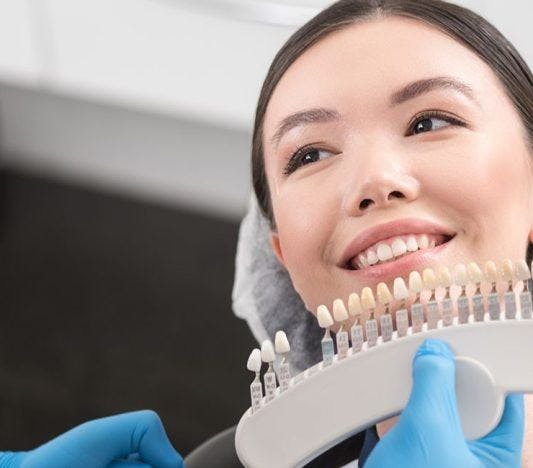The simple act of turning your frown upside down can lift your mood. So what happens when tooth loss threatens to dampen your spirits? That missing gap in your smile can cast a shadow on your confidence, making you feel conscious every time you open your mouth to speak or share a laugh. Thankfully, dental implants offer a permanent solution to this problem.
How do dental implants work? What sets them apart from other teeth replacement options, such as dentures and dental bridges? Keep scrolling to learn about the process and the telltale signs you might need this transformative treatment.
What are dental implants?
Did you know that implant dentistry is the second-oldest dental practice? It dates back to ancient Egypt. Humans would place carved seashells to replace broken teeth. But thanks to technological advances, dentists can now place artificial tooth roots into the jawbone and replace teeth with ceramic. These tooth-shaped caps make the procedure safer and more reliable.
The process begins with a comprehensive dental examination to check your bone density and gum condition. If you’re an eligible candidate, the next step is the surgical placement of the screw-like implant into the jawbone in place of your old tooth root.
Previously, osseointegration, when the implant fuses with the surrounding bone, took three months. Luckily, advancements in dentistry now allow for immediate loading and restoration, reducing the time required based on the suitability of each case. Then, the treating dentist attaches an abutment (supporting structure) to the top and covers it with a new crown.
Why get dental implants?

Dental implants are considered a good option for tooth replacement for numerous reasons:
- According to a 2021 Clinical Implant Dentistry and Related Research study, they have a higher success rate (98.5%) than dentures (92%).
- Implants don’t generally damage the surrounding healthy teeth, unlike bridges.
- You can usually floss, brush your teeth, and eat normally without any problem.
- With proper maintenance, your new teeth can last for up to 20 years
How dental implants can benefit you
Dental implants can significantly improve your quality of life! Here are some benefits that make them a worthwhile investment.
They can replace your missing tooth.
Accidents happen. Whether you’ve fallen victim to a slippery floor or suffered an injury from rollerblading, a damaged tooth (or teeth!) can affect your ability to chew and pronounce certain words. If you ignore it for too long, the underlying jawbone can also deteriorate because no tooth root supports its growth. The sad part? This can make your face look sunken.
They provide a solution for decaying teeth.

According to a study published in the International Journal of Environmental Research and Public Health, tooth decay and gum disease are the most common causes of tooth extraction. When it comes to cavities, many people only seek dental attention when they experience pain in their teeth. However, this often indicates that the dentin is decayed and the damage has already reached the nerves. On the other hand, severe gum disease can lead to bone and tooth loss. In such cases, dental implants can solve your predicament.
Another bonus? Dental implants are not susceptible to cavities because of their metal and porcelain composition.
They don’t fall out.
Here’s a little not-so-fun fact: your gum and jaw tissue slowly shrink after tooth extraction. However, unlike dentures that can loosen and easily slip off, dental implants integrate with your jawbone, typically becoming just as strong as natural teeth. This means you can enjoy a confident smile without worrying about loose dentures or discomfort.
What to do after getting dental implants
Is it painful to have dental implants put in? The procedure itself shouldn’t involve any pain, especially with the use of anaesthesia. However, you might feel discomfort once you get home. As such, you should follow these tips to ease your recovery:
- Take prescribed pain medication.
- Limit your physical activities.
- Avoid crunchy, hard, and spicy foods.
Alternatives to dental implants
Dental implants aren’t for everyone. Insufficient bone density, gum disease, jawbone deformities, and certain medical conditions can dampen your dental implant dreams. That said, there are alternatives to helping you get your dream smile. Here are some of them:
- Dental bridges use adjacent teeth to anchor a false tooth, filling in a gap.
- Dentures are removable prosthetic devices that replace missing teeth. They are a more affordable, non-surgical option, and come in full or partial sets.
- Tooth-supported crowns are an option when only a single tooth is missing and adjacent teeth need crowns. This option can provide a functional replacement without implants.
- Flippers are a temporary partial denture that replaces one or more teeth. It’s usually a short-term solution while waiting for a more permanent option.
- Veneers are shells that cover the surface of your teeth. They’re ideal for minor gaps, chips, overcrowding, or discolouration. However, veneers need existing teeth as an anchor.
Can you wear braces if you have dental implants?

Yes, as long as you’re over 18 years old. Dental implants are not suitable for teenagers who haven’t reached skeletal maturity. But yes, it’s possible to have braces before or after your implant placement. They can even help in fixing the alignment of the surrounding teeth. Don’t worry about the brackets moving or damaging the artificial tooth root as it’s deeply attached inside your jawbone.
However, getting braces can make it harder for you to brush and floss. Instead, you can opt for clear aligners, like ClearCorrect, to straighten crooked teeth without discomfort. Despite the powerful stain-resistant three-layer plastic, they’re barely visible. No one will notice you’re undergoing alignment therapy.
Both orthodontic appliances and dental implants are great investments that go beyond just filling gaps. They can restore your beautiful smile and, most importantly, keep your oral health in tip-top shape. Consult your dentist to determine the most suitable treatment plan for your condition.
References:
Alraheam, I. A., Ngoc, C. N., Wiesen, C. A., & Donovan, T. E. (2018). Five-year success rate of resin-bonded fixed partial dentures: A systematic review. Journal of Esthetic and Restorative Dentistry, 31(1), 40-50.
Dental implants – Australian dental association. Teeth.org.au. (n.d.).
French, D., Ofec, R., & Levin, L. (2021). Long term clinical performance of 10 871 dental implants with up to 22 years of follow-up: A cohort study in 4247 patients. Clinical Implant Dentistry and Related Research, 23(3), 289-297.
Gaviria, L., Salcido, J. P., Guda, T., & Ong, J. L. (2014). Current trends in dental implants. Journal of the Korean Association of Oral and Maxillofacial Surgeons, 40(2), 50-60.
Marmolejo-Ramos, F., Murata, A., Sasaki, K., Yamada, Y., Ikeda, A., Hinojosa, J. A., Watanabe, K., Parzuchowski, M., Tirado, C., & Ospina, R. (2020). Your face and moves seem happier when I smile. Experimental Psychology, 67(1), 14–22.
Passarelli, P. C., Pagnoni, S., Piccirillo, G. B., Desantis, V., Benegiamo, M., Liguori, A., Papa, R., Papi, P., Pompa, G., & D’Addona, A. (2020). Reasons for tooth extractions and related risk factors in adult patients: A cohort study. International Journal of Environmental Research and Public Health, 17(7), 2575.



